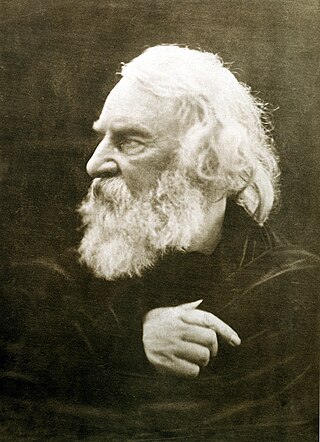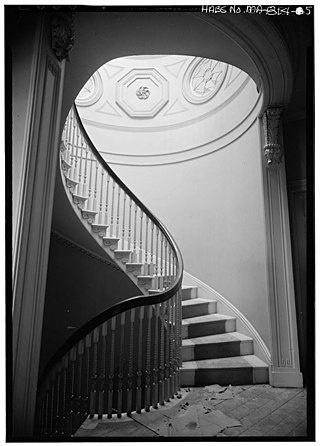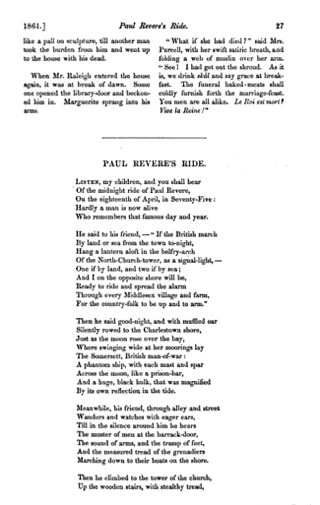
Henry Wadsworth Longfellow was an American poet and educator. His original works include the poems "Paul Revere's Ride", "The Song of Hiawatha", and "Evangeline". He was the first American to completely translate Dante Alighieri's Divine Comedy and was one of the fireside poets from New England.

The Wadsworth-Longfellow House is a historic house and museum in Portland, Maine, United States. It is located at 489 Congress Street and is operated by the Maine Historical Society. It was designated a National Historic Landmark in 1962, and administratively added to the National Register of Historic Places in 1966. The house is open daily to public from May through October. An admission fee is charged.

The Longfellow House–Washington's Headquarters National Historic Site is a historic site located at 105 Brattle Street in Cambridge, Massachusetts. It was the home of noted American poet Henry Wadsworth Longfellow for almost 50 years, and it had previously served as the headquarters of General George Washington (1775–76).

Nathan Appleton was an American merchant and politician and a member of the group of entrepreneurs known as "The Boston Associates".

Thomas Gold Appleton, son of merchant Nathan Appleton and Maria Theresa Gold, was an American writer, an artist, and a patron of the fine arts. Henry Wadsworth Longfellow became his brother-in-law after marrying Appleton's sister Frances.

"Excelsior" is a short poem written in 1841 by American poet Henry Wadsworth Longfellow.
Nathan Cooley Keep (1800–1875) was a pioneer in the field of dentistry, and the founding Dean of the Harvard School of Dental Medicine.

Tales of a Wayside Inn is a collection of poems by American poet Henry Wadsworth Longfellow. The book, published in 1863, depicts a group of people at the Wayside Inn in Sudbury, Massachusetts as each tells a story in the form of a poem. The characters telling the stories at the inn are based on real people. The compilation, which Longfellow originally wanted to title "The Sudbury Tales", proved to be popular and he issued two additional series in the 1870s.
Nationality words link to articles with information on the nation's poetry or literature.

The Nathan Appleton Residence, also known as the Appleton-Parker House, is a historic house located at 39–40 Beacon Street in the Beacon Hill neighborhood of Boston, Massachusetts. It was designated a National Historic Landmark for its association with revolutionary textile manufacturer Nathan Appleton (1779–1861), and as the site in 1843 of the wedding of his daughter Frances and poet Henry Wadsworth Longfellow. The house is an excellent early 19th century design of Alexander Parris.
"The Saga of King Olaf" is a poetic sequence by American poet Henry Wadsworth Longfellow, published in 1863 as part of his book Tales of a Wayside Inn.

"The Children's Hour" is a poem by American poet Henry Wadsworth Longfellow, first published in the September 1860 edition of The Atlantic Monthly.

Windmill Cottage is a historic house and former windmill at 144 Division Street in East Greenwich, Rhode Island. It was the home of George Washington Greene, a former American consul to Rome and historian. It was purchased for Greene by his friend, the poet Henry Wadsworth Longfellow.

"The Village Blacksmith" is a poem by Henry Wadsworth Longfellow, first published in 1840. The poem describes a local blacksmith and his daily life. The blacksmith serves as a role model who balances his job with the role he plays with his family and community. Years after its publication, a tree mentioned in the poem was cut down and part of it was made into an armchair which was then presented to Longfellow by local schoolchildren.

"A Psalm of Life" is a poem written by American writer Henry Wadsworth Longfellow, often subtitled "What the Heart of the Young Man Said to the Psalmist". Longfellow wrote the poem not long after the death of his first wife and while thinking about how to make the best of life. It was first published anonymously in 1838 before being included in a collection of Longfellow's poems the next year. Its inspirational message has made it one of Longfellow's most famous poems.

"Paul Revere's Ride" is an 1860 poem by American poet Henry Wadsworth Longfellow that commemorates the actions of American patriot Paul Revere on April 18, 1775, although with significant inaccuracies. It was first published in the January 1861 issue of The Atlantic Monthly. It was later retitled "The Landlord's Tale" in Longfellow's 1863 collection Tales of a Wayside Inn.

Hyperion: A Romance is one of Henry Wadsworth Longfellow's earliest works, published in 1839. It is a prose romance which was published alongside his first volume of poems, Voices of the Night.

Norman's Woe is a rock reef on Cape Ann in Gloucester, Massachusetts, about 500 feet offshore.

Henry Wadsworth Longfellow is a bronze statue, by William Couper, and Thomas Ball. The statue depicts American poet Henry Wadsworth Longfellow. It is located at the intersection of M Street and Connecticut Avenue, N.W. Washington, D.C., and was dedicated on May 7, 1909.

Richard Henry Dana III was an American lawyer and civil service reformer.

















